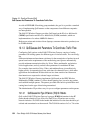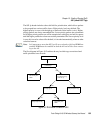Psion Teklogix 9160 G2 Wireless Gateway User Manual 183
Chapter 19: Quality of Service (QoS)
Understanding QoS
Quality of Service (QoS) provides you with the ability to specify parameters on
multiple queues for increased throughput and better performance of differentiated
wireless traffic like Voice-over-IP (VoIP), other types of audio, video, and streaming
media, as well as traditional IP data over the 9160 G2 Wireless Gateway.
The following sections describe how to configure Quality of Service queues on the
9160 G2 Wireless Gateway.
19.1 Understanding QoS
A primary factor that affects QoS is network congestion due to an increased number
of clients attempting to access the air waves and higher traffic volume competing for
bandwidth during a busy time of day. The most noticeable degradation in service on
a busy, overloaded network will be evident in time-sensitive applications like Video,
Voice-over-IP (VoIP), and streaming media.
Unlike typical data files which are less affected by variability in QoS, Video, VoIP
and streaming media must be sent in a specific order at a consistent rate and with
minimum delay between Packet transmission. If the quality of service is compro-
mised, the audio or video will be distorted.
19.1.1 QoS And Load Balancing
By using a combination of load balancing (see Chapter 18: “Load Balancing”) and
QoS techniques, you can provide a high quality of service for time-sensitive appli-
cations even on a busy network. Load balancing is a way of better distributing the
traffic volume across access points. QoS is a means of allocating bandwidth and
network access based on transmission priorities for different types of wireless traffic
within a single access point.
19.1.2 802.11e And WMM Standards Support
QoS describes a range of technologies for controlling data streams on shared
network connections. The IEEE 802.11e task group is in the process of defining a
QoS standard for transmission quality and availability of service on wireless net-
works. QoS is designed to provide better network service by minimizing network
congestion; limiting Jitter, Latency, and Packet Loss; supporting dedicated band-
width for time-sensitive or mission critical applications, and prioritizing wireless
traffic for channel access.


















